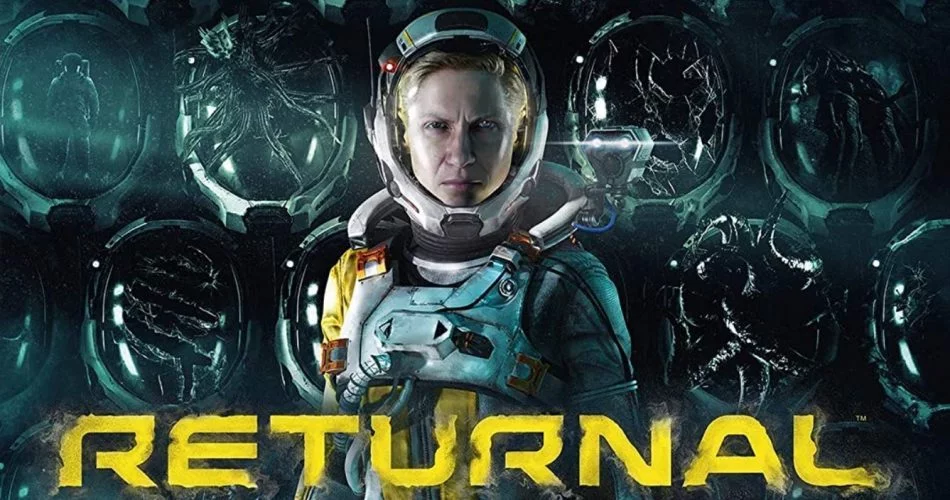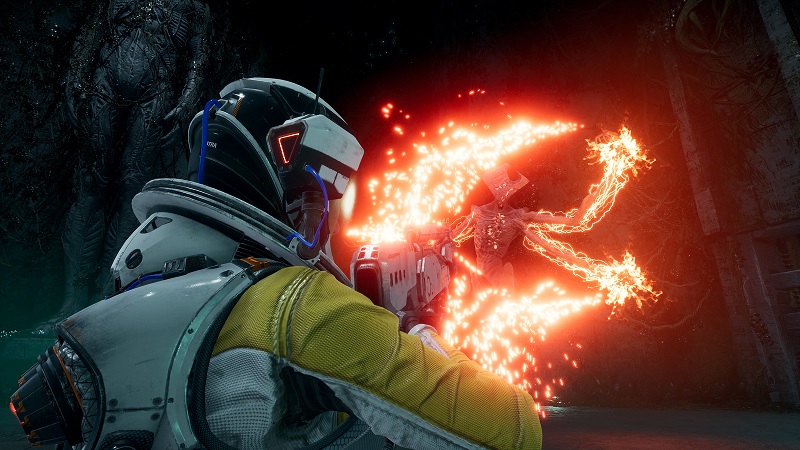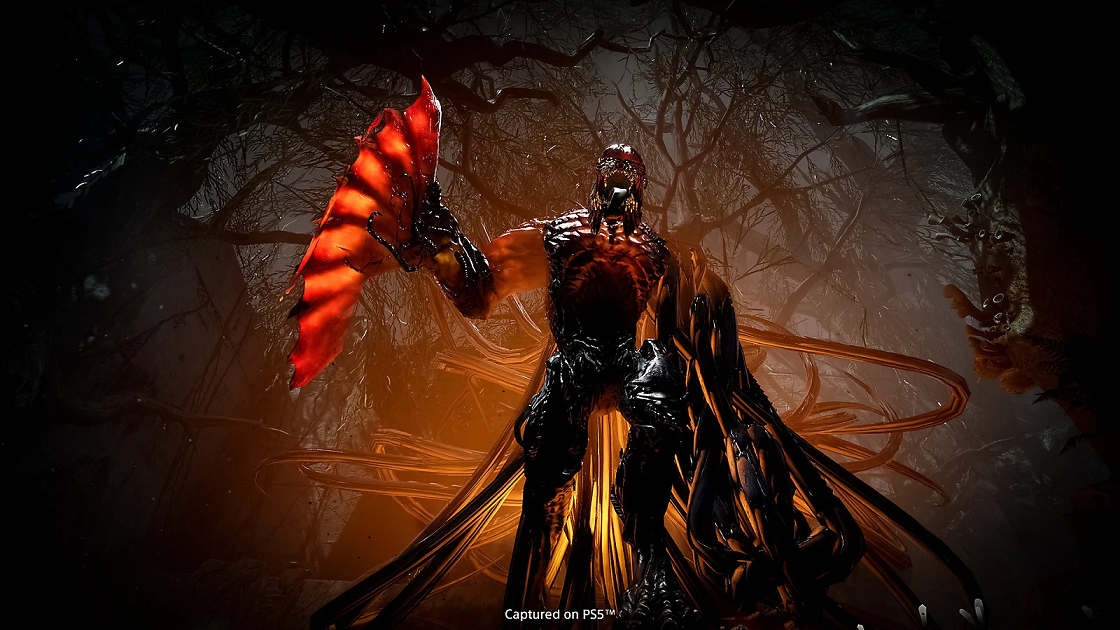Returnal’s core conceit is about breaking the cycle. Selene crashes her ship on the mysterious—and dangerous—planet of Atropos, and every time she dies, she is returned to the crash site. The world changes around each time she sets out anew, learning new things about her situation on the alien planet and figuring out how it all ties together. The goal is to find a way to free Selene from this vicious unending cycle of death and rebirth, but Returnal is so good, I never want the cycle to end.
I’ve already written extensively about my experience with Returnal’s first two biomes in our early preview. We called it the first truly next-gen game. We praised its implementation of the unique DualSense features and PS5’s 3D audio. Seriously, the haptic feedback at work is some of the most impressive stuff we’ve seen felt, and the adaptive triggers make for distinct gameplay that utilize multiple levels of pressure for focused aim and alternate fire abilities. As part of that initial preview, I also said:
It’s a sci-fi bullet-hell third-person shooter roguelike metroidvania that’s simultaneously empowering and crushing, always begging for one more cycle, one more run to try to conquer the creatures and discover the mysteries of Atropos. Some runs you’ll easily work your way through the levels, and others will present you with sudden terrifying surprises that lead to a quick defeat, but that random nature just makes you want to play more.
Returnal bears some clear influences from many of sci-fi’s greatest movies, moments, and environments, but it never feels like it is merely copying those elements. Every step of the way, it bravely sets its own identity while paying humble homage to what came before. It’d be all too easy to list any number of properties that have at least seemed to have an influence, both sci-fi films and notable video games—everything from Aliens, to Journey, to Hades—but Returnal’s gentle respect for these things is an undercurrent to the strong core identity of this game. Returnal is Housemarque. It’s Housemarque different than you’ve ever seen Housemarque before, but it’s also distinctly and undeniably a Housemarque game with no exceptions.
Returnal Review – Helios Abandoned
A visually stunning experience, Returnal leans heavily into those trademark Housemarque particle effects and physics. But far from just a bunch of tiny voxels bouncing around the screen and neon tentacles flailing from many of the game’s enemies, Housemarque outdid themselves with Returnal’s environments. From the dark and rainy overgrown ruins you start in, to the expansive martian-like desert and its enormous citadel, to a few others that are best left to the awe of discovering them for the first time on your own, the environments each feel distinct—even within the various individual biomes. From the moment you leave your crashed ship, Helios, behind, you’re in for a visual treat throughout.
A small detail, Selene’s suit also appropriately changes to match the worlds she’s in, embodying the look of a world-weary traveler who has come a long way from that initial crash site again and again. Red dust cakes her mask and folds in her suit as she treks through the desert landscape. Should she happen to find herself in a colder environment, her suit will appropriately take on the related icy visuals. The only downside to the excellent visual treat that is Returnal is the lack of a photo mode to capture it all with.
The randomization and changing of the world each new cycle means that there’s a constant feeling of discovery. Even more than 20 hours into the game, after rolling credits and getting to the “end” (can a cycle ever end?), I was still discovering new pieces and elements to each biome when I’d continue to play. And continue to play I did, and still am. Games that make me want to restart and keep going after the credits are few and far between, but that’s precisely what I did when Returnal’s credits finished. Returnal is the kind of game that I don’t ever want to end, and with how unique each cycle feels—and how much there is to discover and upgrade—it doesn’t have to. I’m well over 20 hours into Returnal, and I don’t feel anywhere close to “done” with this game.
I should also say that Returnal does have a satisfying enough “conclusion” of sorts if you do manage to roll credits. But with how much of Returnal’s narrative is deeply layered into the world and the gameplay, learning new bits and pieces throughout each and every cycle, stopping there would almost feel like getting the abbreviated summary. There are a lot of small elements and puzzle pieces to put together, some crucial to the central narrative, and some just delightful additional flavor as it explores Selene’s story. I’m hesitant to dive any further into it here because I feel the narrative discovery is an element of Returnal that is just as crucial as its fast-paced gameplay.
What I will say about the story is that it doesn’t just feel tacked on for the sake of adding a narrative to this bullet-hell roguelike. Everything feels very deeply intertwined, and it prompts some deep introspection into themes like identity and self, guilt, blame, and plenty of other very relatable topics. I couldn’t help but think about The Swapper as I played in, in part because Selene’s repeated cycles and coming upon her own corpse from previous (and perhaps future?) cycles seems to beg the question of which version of you is you. I feel like I’ve already said too much here, and this is barely scratching the surface of what you’ll discover as you play and piece together the various narrative elements and how they all connect.
Returnal Review – Learn From the Cycle
Roguelike games tend to challenge players with knowledge. Death resets just about everything, and the only thing you take with you into the new run is the knowledge of your last, building out strategies to conquer the unconquerable. At first, I’d avoid doors marked with big golden or red icons, rooms I knew contained tough gauntlets of enemies (through previous experience). As I learned and grew over time, I’d cautiously start taking these challenges on, eventually welcoming the opportunity to earn Obolites (the game’s currency), weapon proficiency, and the other rewards that these rooms offered.
There are multiple tiers of what carries over between cycles. There are certain permanent upgrades which make new cycles a whole different experience. Can’t quite reach that platform or see an item that seems impossible to reach right now? More than likely, you’ll gain an ability at some point that will enable you to eventually get it. You may not be able to get it on this cycle, but that knowledge and power makes returning to Returnal’s earliest areas a whole new experience of discovery with the added abilities.
Additionally, there are weapon upgrades that you slowly earn and unlock permanently. These new traits will appear in random combinations on your weapons, but having them unlocked can create some god tier rolls that completely change how you play the game. That starting sidearm might feel pretty weak and basic early on, but prioritize unlocking various traits on it and you’ll find a pretty formidable weapon. This also creates an exciting element to gameplay that encourages you to try out new weapons rather than just sticking with one old favorite. I tended to prefer the Carbine in my earliest runs, but found a lot of appreciation for other weapons as I made use of them all.
Then there are cycle upgrades that vanish when you die and restart the cycle. These can make all the difference between a solid run and struggling with a few of the game’s tougher enemies (of which there are quite a lot). Learning how to best spend Obolites and adapt your playstyle to the various Artifacts and Suit Upgrades available is part of the discovery that Returnal is all about. Much of it is based in risk and reward, with some of the better bonuses often also giving you some big disadvantages. With Obolites a relatively limited resource, you’ll have to carefully manage what you’re buying at various opportunities. Do you want that consumable that will give you a bit of health back, or an artifact that will give you a permanent boost of some kind?
Fortunately those permanent upgrades that persist between runs helps Returnal to feel like you still gain something of value even when you take a big risk and fail. And even better is when you take the big risk and it pays off in a big way, perhaps being precisely the ability or upgrade that you needed to clinch the boss fight this time. For me, Returnal felt like a really hard game until it wasn’t. At a point, something clicked, and while I still die in a variety of often stupid ways that are my own fault, the more I play, the more adventurous I am getting. I play more aggressively. I take bigger risks. I use weapons that I wouldn’t have previously. While permanent upgrades have certainly helped that process a long, there’s a lot that comes simply from the knowledge I’ve gained. Returnal’s difficulty is mitigated by me simply knowing how to play smarter, how to approach certain enemies and situations, and how to manage my various upgrades and items to the best effect.
A final layer of upgrades is a series of bonuses in the Adrenaline system, which rewards you for getting kills without taking a hit. You’ll get bonuses like easier Overloads (the “reload” mechanic), faster weapon proficiency gains, and bonus Obolites if you can maintain a max level Adrenaline meter. Take one hit, however, and that all comes tumbling down. It’s a great way to promote playing smart, offering meaningful bonuses while also not being completely discouraging if you do somehow take a glowy neon bullet to the face. And there are some artifacts and other bonuses that tie into your Adrenaline level, like one artifact I got that gave me a certain percentage of health back as I dealt damage depending on what my Adrenaline level was. Let me tell you, that was a magical run.
I did run into a couple of very minor bugs in my 25 hours with the game. While none were overtly game breaking, there were definitely a couple of noticeable issues such as items not showing up on the minimap and one instance of my weapon simply deciding not to fire until after I had careened into a pit. The most egregious issues seem to be with Trophy unlocks. Despite completing the game and defeating the final boss, I still don’t have the Trophy for doing so. I also don’t have the associated story Trophies for reaching that point in the game. There are a few others that I have met the conditions for but still show as locked for me right now, though some of them have randomly popped when I restart the application.
There is a Day 1 patch incoming that will issue a number of bug fixes, which should help to smooth over these spots. Overall, for a game played entirely ahead of its Day 1 patch however, Returnal is in a really good place. It feels like an exceptionally polished experience. Even considering the Trophy issues, the game itself is near flawless, and any minor problems are easily overlooked.
Is Returnal Worth the $70 Price Tag?
Normally we’re careful not to address price points within a review. After all, the perception of value can and will vary wildly between any two people, and the price of the game will change over time while the review will not. But there’s been a lot of talk about Housemarque, a studio frequently praised for its smaller indie bullet-hell shooters, taking on a premium AAA project at the industry’s top price point. Sure, the game is good—stellar, even—but is it worth that $70 at launch?
I’d argue yes. A single successful run can take hours, and that’s not factoring in the multitude of deaths you are apt to face. It took me nearly 20 hours of gameplay to finally roll credits for the first time, and that’s hardly the end of the experience. There’s still plenty more to do and discover. Returnal is the kind of game that I pick up expecting to maybe do a cycle or two, and end up playing for the entire evening. Whether it’s because I found myself in a solid run that I don’t want to end, or I get addicted to the cycle of starting and starting again, Returnal has fully captured my attention for the past couple of weeks and the foreseeable future.
Returnal also has a brilliant online component that lets you see where other players’ Selenes have fallen within the world, and you’ll sometimes even need to take down a tentacled reanimation of their corpse. Are they you? Are you them? Is the cycle linear, or layered? Even this online element that brings other players into the picture begs questions of the narrative. There’s also an entire challenge mode that pits players in specific biome arrangements with specific conditions for scored runs, trying to place on the leaderboards. These challenge runs really embody that classic arcadey Housemarque spirit and give Returnal even more options and reasons to play.
Returnal is an essential PS5 title, now and throughout the console’s life. Housemarque took the rogue-like bullet-hell formula and applied it to a AAA experience in a way that creates something exceptionally unique yet wholly familiar. Returnal is an engaging experience in narrative, gameplay, and player discovery, consistently surprising on every level. Utilizing the PS5 technology in a way that most other developers are barely tapping into, Returnal feels like one of the first truly next-gen experiences, letting Housemarque set the stage for the new console. And like Housemarque games before it, it’s the kind of game that will withstand the test of time, begging for additional cycles well into the future.
Returnal review code provided by publisher. Reviewed on PS5. For more information, please read our Review Policy.
-
Consistently engaging player discovery
-
Narrative and gameplay weave together
-
Use of PS5 features is incredible
-
Almost impossible to put the controller down
-
Great balance of challenge and empowerment, risk/reward gameplay
-
No photo mode
-
You may run into Trophy unlock issues












